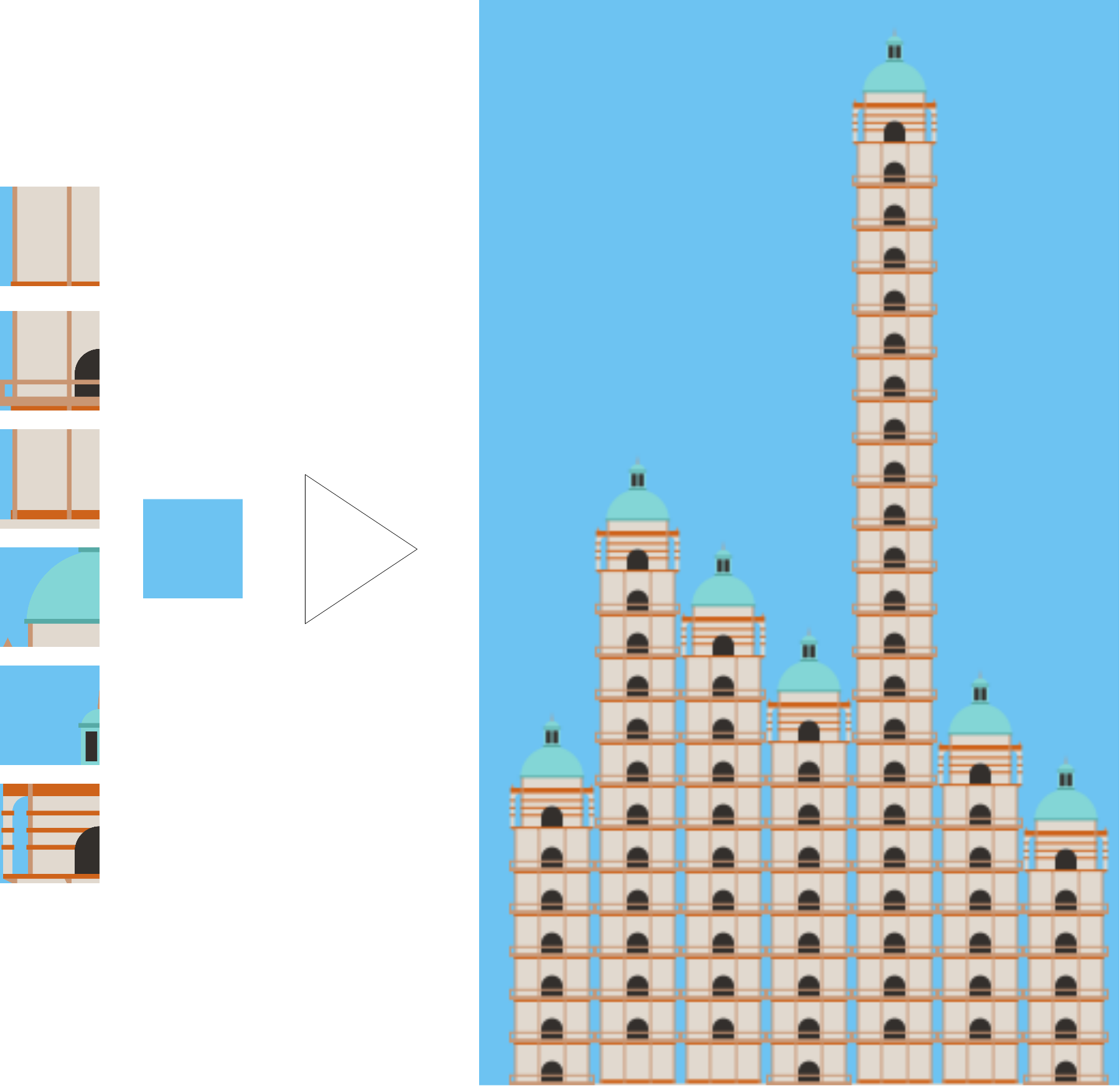This project was based on the Maxim Gumin's wave function algorithm.
The program determines a bitmap based on the input consisting of smaller tiles (.png) as well as a set of constraints (.xml). The purpose is to create an image that is locally similar to the input images.
- Introduction
- Local similarity
- Algorithm
- Possible extensions
- Getting started
- Documentation
- References
- Credits and licences
The name of the algorithm stems from the Quantum Mechanics, where it refers to a behaviour of minuscule particles which gradually determines their position in space. Similar in a broad sense, WaveFunctionCollapse (WFC) determines the orientation and coordinates of input tiles based on initial constraints. Let us consider a simplified example:
-
The bitmap consists of two spaces for tiles, which can be occupied by any of the four tiles with equal probabilities. The entropy of each space is 4 now. In our model, the algorithm will always choose the minimum not-equal-to-one entropy space and then choose randomly.
-
Let us say that the right space was chosen with a head occupying it. Now only straight and tail tiles satisfy the neighbourhood rules. The choice of the head tile propagates itself throughout the grid.
-
The tail is chosen at random. Valid image is determined, collapse terminates.
This execution principle is extended for custom tilesets and sizes of grids. Have a look at the image generated by the tiles inspired by Imperial College London, our home institution:
As you can probably spot, tiles can be rotated and flipped, the grid does not have to be a square, any rectangular shape can be specified.
This means in principle that:
Tiles from the tileset built up the image (ideally all tile types are present in the image at least once, subject to constraints).
The input consists of several files separated into two groups: constraints and images.
Constrains is a single .xml file formatted as the following example:
<!-- dir = path_to_directory_with_png_files
size_x = width
size_y = height
-->
<tiles dir="./graphics/huxley_tiles/" size_x="10" size_y="10">
<!-- each tile box follows the same pattern -->
<!-- neccessary arguments
file = name of the file
top/right/bottom/left = string that will be checked for equality, tiles with equal
values can be placed next to each other -->
<!-- optional arguments -->
<!-- flip:
1 - add a vertically flipped tile to the tileset
2 - add a horizontally flipped tile
3 - add both of the flips -->
<!-- rotate:
1 - 90 degrees
2 - 180 degrees
3 - 270 degrees -->
<tile file="sky.png" top="sky" right="sky" bottom="sky" left="sky"/>
<tile file="qtr_base.png" top="qtr" right="qtr_base" bottom="pavement" left="sky" flip="2"/>
<tile file="qtr_balcony.png" top="qtr" right="qtr_balcony" bottom="qtr" left="sky" flip="2"/>
<tile file="qtr_top_balcony.png" top="qtr_1" right="qtr_top_balcony" bottom="qtr" left="sky" flip="2"/>
<tile file="qtr_dome.png" top="qtr_2" right="qtr_dome" bottom="qtr_1" left="sky" flip="2"/>
<tile file="qtr_spire.png" top = "sky" right="qtr_spire" bottom ="qtr_2" left="sky" flip="2" rotate = "1"/>
<!-- optional constraints that set grid space to a particular tile type
file = name of the file
x/y - coordinates of the space (origin is upper left!)
-->
<constraint file="telephone.png" x="3" y ="9"/>
</tiles>This is a subdirectory with png files of the same width and height (and all square). See the graphics folder in the source.
- Read the input with optional rotations, flips and constraints.
- Initialise a 2D array of 64 bitstrings (each bit corresponding to a tile type). True represents that a tile can occupy given space, false - the opposite. We will want all of those to have exactly one-bit set. Without specified constraints, all bitstrings will be set to 11111...
- Loop:
3a. Observation: Find elements of minimum entropy greater not equal to 1 (these spaces are already collapsed). If this is positive, go to the next step, otherwise, abort (a valid solution was not found).
3b. Choose the element at random and collapse it (make its entropy 1).
- If successfully terminated, we have a valid image generated.
We have implemented a live updated working of the algorithm. It shows the average of pixel colours of each tile possible in an element. Here is an example:
Also the output will be saved as an image in the output.jpg file in the root directory.
The current state of the project represents 2 weeks of teamwork. We are aware that there are multiple aspects which could be improved, most notably:
- Setting the relative frequency of the tiles
- Extending the program to more dimensions (3D)
- Providing an interactive interface for users
- Adding more tilesets
If you feel like you would like to contribute, please do not hesitate to message us or submit a pull request. We will gladly provide you with expertise and cooperation!
Unfortunately, there is currently no support for Windows, if you would like to contribute in this area please message us!
First you will need to install needed libraries in your terminal:
Ubuntu/Linux:
sudo apt-get install libxml2
sudo apt-get install imagemagickmacOS:
brew install libxml2
brew install imagemagick && brew link imagemagick --forceTo build the project using Make run:
makeProvided make ran successfully, run_wfc has been created in the main folder. You can now run the program:
./run_wfc path/to/tileset.xmlWe've set up a few sample tilesets for you to try out:
./run_wfc sample_inputs/python.xml
./run_wfc sample_inputs/rpg_map.xml
./run_wfc sample_inputs/huxley.xmlThe official report is available here, please jump straight to section 3 for relevant information.
- Maxim Gumin's wave function algorithm
- Isaac Karth and Adam M. Smith paper presented at the Genetic and Evolutionary Computation Conference
- Oskar Stalberg
Authors:
This project is licensed under the terms of the MIT license, excluding the files listed below:
Tile art in graphics/rpg\_map is Overworld rpg tileset by Tayoko (licensed under CC BY-SA 3.0) available at opengameart.org/content/overworld-rpg-tileset



